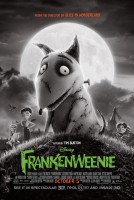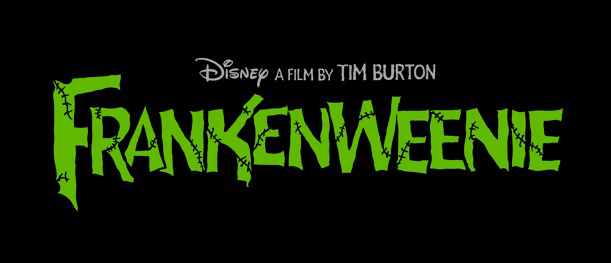“Frankenweenie” follows in the footsteps of Tim Burton’s other stop-motion animated films “Corpse Bride” and “The Nightmare Before Christmas”—both of which were nominated for Academy Awards®.
Stop-motion animation is one of the oldest animation styles (and one of the best). There are 24 frames per second in the stop motion for “Frankenweenie.” This means that the animator must stop and position the puppet 24 times to get one second of filmed action. On average, one animator can only produce 5 seconds of animation per week. Multiple puppets of the same character allowed animators to work on more than one scene at once. There were as many as 18 animators working independently of each other at one time.
 “Frankenweenie” is the first animated film that Tim Burton has directed for Disney.
“Frankenweenie” is the first animated film that Tim Burton has directed for Disney.
All of the characters in “Frankenweenie” are based on Tim Burton’s drawings. He did some of the drawings in 1984 when the original live-action short of “Frankenweenie” was done and the others he drew especially for this new, feature-length animated version.
The talented voice cast includes four actors who worked with Burton on previous films: Winona Ryder (“[amazon_link id=”B001AGXEA6″ target=”_blank” ]Beetlejuice[/amazon_link],” “[amazon_link id=”B000VDDWDI” target=”_blank” ]Edward Scissorhands[/amazon_link]”), Catherine O’Hara (“Beetlejuice,” “[amazon_link id=”B003UMW68Y” target=”_blank” ]The Nightmare Before Christmas[/amazon_link]”), Martin Short (“[amazon_link id=”B003M8NG94″ target=”_blank” ]Mars Attacks[/amazon_link]!”) and Martin Landau (“[amazon_link id=”B008BSM1GO” target=”_blank” ]Ed Wood[/amazon_link],” [amazon_link id=”B008BSM1GO” target=”_blank” ]Sleepy Hollow[/amazon_link]”).
Production designer Rick Heinrichs enjoys a long-standing professional relationship with director/producer Tim Burton, having worked in various capacities on many of Burton’s films, including “Sleepy Hollow,” for which he won an Academy Award®; short films “Vincent” and the live-action “Frankenweenie”; feature films “Pee-wee’s Big Adventure,” “Beetlejuice,” “Edward Scissorhands,” “Batman Returns,” “The Nightmare Before Christmas” and “Planet of the Apes.” Most recently, Heinrichs designed the Burton-directed, live-action feature “Dark Shadows.”
Classic horror films from the 1930s, like “[amazon_link id=”B006TTC5J0″ target=”_blank” ]Frankenstein[/amazon_link]” and “[amazon_link id=”B006TTC5J0″ target=”_blank” ]Dracula[/amazon_link],” inspired several of the character names—Victor, Elsa Van Helsing, Edgar “E” Gore and Mr. Burgemeister.
Over 200 puppets and sets were created for the film; there were 17 Victors and 12 Sparkys. Since each animator worked independently on different scenes, multiples were needed. They also needed backup in case a puppet required repair.
The Puppet Hospital on the “Frankenweenie” set was always full. These highly trained model makers spent months repairing limbs, fixing hair and skin issues and mending costumes that were ripped or dirty. This team even found time to create all of the generic background puppets as well as a few of the main characters from scratch.
The first puppet designed for the show was Sparky and the scale that they established with him set the standard for the whole rest of the film. Tim Burton had a very specific vision for Sparky’s character and really wanted him to act and move like a real dog. The armature needed to be very intricate and 4 inches is literally the smallest they could make him and still have him display all the behavior and personality that was required. Once they had his size fixed, the puppet makers were able to scale the rest of the characters and sets properly.
Incredibly talented artists are able to take Tim Burton’s original drawings and sculpt them into three-dimensional sculptures, which are then cast in a combination of silicone and latex. Their costumes are all sewn with miniature stitches to keep in scale. Wigs are made for them from real human hair and then applied strand by strand so that the puppets have a more realistic hairline. Inside each puppet there is a metal armature, which acts like a skeleton and gives the animator the ability to move the puppets and act out the scenes with incredible subtlety and finesse.
The film takes place in the fictitious town of New Holland, a suburban development circa the 1970s, much like Burbank, California, where director Tim Burton grew up. A windmill sits on a hill overlooking the town and adds just the right touch for New Holland’s annual Dutch Days celebration.
The sets for the film were built on tabletops. The vast majority of the miniature props for the sets were made by hand and hand-painted and detailed.
The music for “Frankenweenie” was composed by Danny Elfman (no surprise there), whose working relationship with Tim Burton goes back to 1985 when Elfman composed the score for “Pee-wee’s Big Adventure.” Elfman has composed the scores for all of Burton’s films thus far, with the exception of two: “Ed Wood” and “Sweeney Todd: The Demon Barber of Fleet Street.”

